A Report on Safety Management Practices in Ship Management Companies
VerifiedAdded on 2023/06/03
|13
|4753
|481
Report
AI Summary
This report examines the factors influencing safety management practices within ship management companies, emphasizing the importance of a comprehensive management system for workplace safety. It highlights that these practices include policies, plans, objectives, organization, procedures, and responsibilities. The report underscores the use of safety management systems in industries with significant safety risks, such as shipping, and notes variations in the success of these systems. Key factors identified as relating to the quality of safety management practices include safety culture, financial performance, and company size. The report further delves into how ethical, financial, and legal aspects determine safety management system practices. It argues that strengthening safety culture is crucial for risky operations within ship companies, enhancing the protection of individuals, society, and the environment through reliable structures and committed personnel. The effectiveness of safety management systems is influenced by both internal and external factors, including safety incentives, management support, and detailed safety plans. The report concludes that human and organizational factors are paramount for safety management, with safety culture, financial stability, and company size significantly impacting the success of safety management practices.
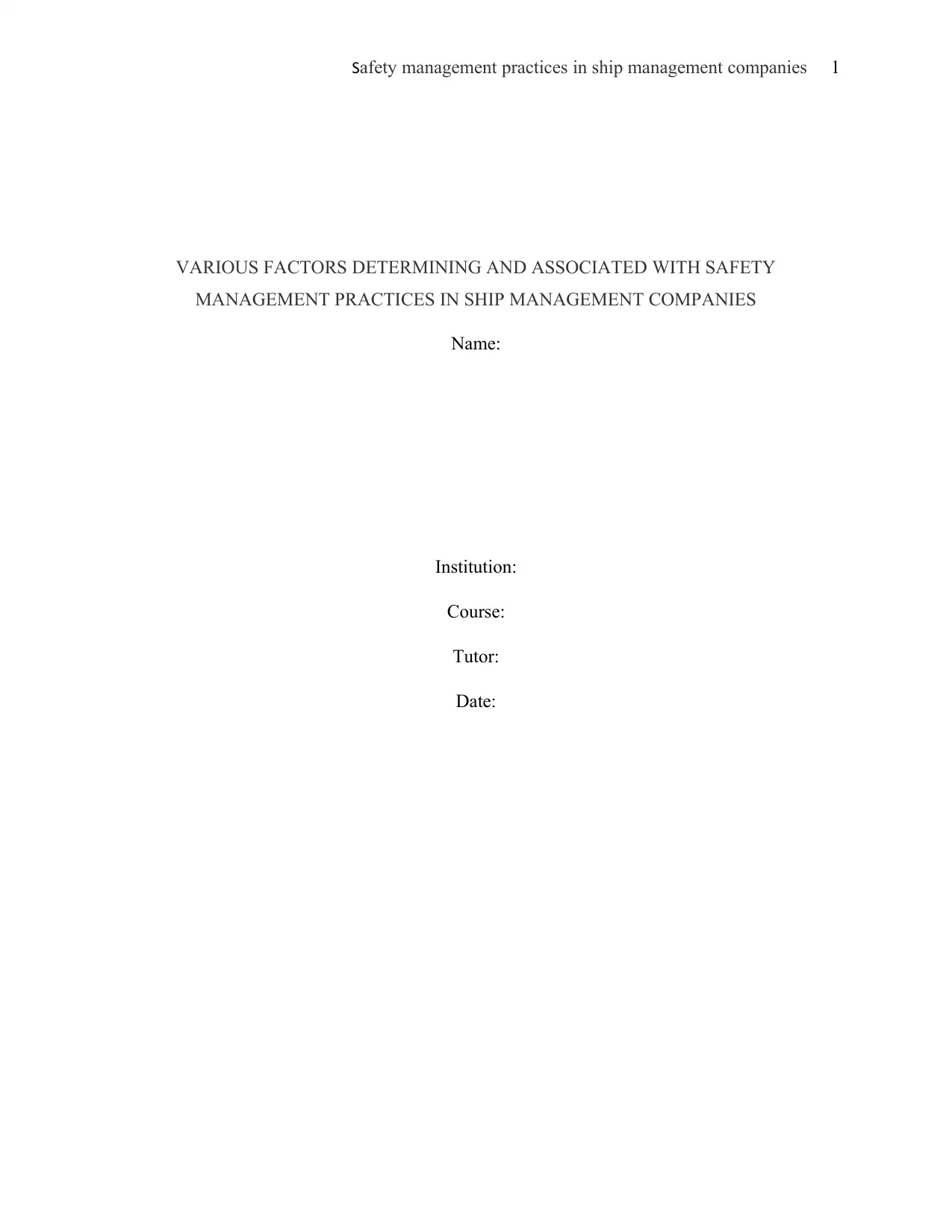
Safety management practices in ship management companies 1
VARIOUS FACTORS DETERMINING AND ASSOCIATED WITH SAFETY
MANAGEMENT PRACTICES IN SHIP MANAGEMENT COMPANIES
Name:
Institution:
Course:
Tutor:
Date:
VARIOUS FACTORS DETERMINING AND ASSOCIATED WITH SAFETY
MANAGEMENT PRACTICES IN SHIP MANAGEMENT COMPANIES
Name:
Institution:
Course:
Tutor:
Date:
Paraphrase This Document
Need a fresh take? Get an instant paraphrase of this document with our AI Paraphraser
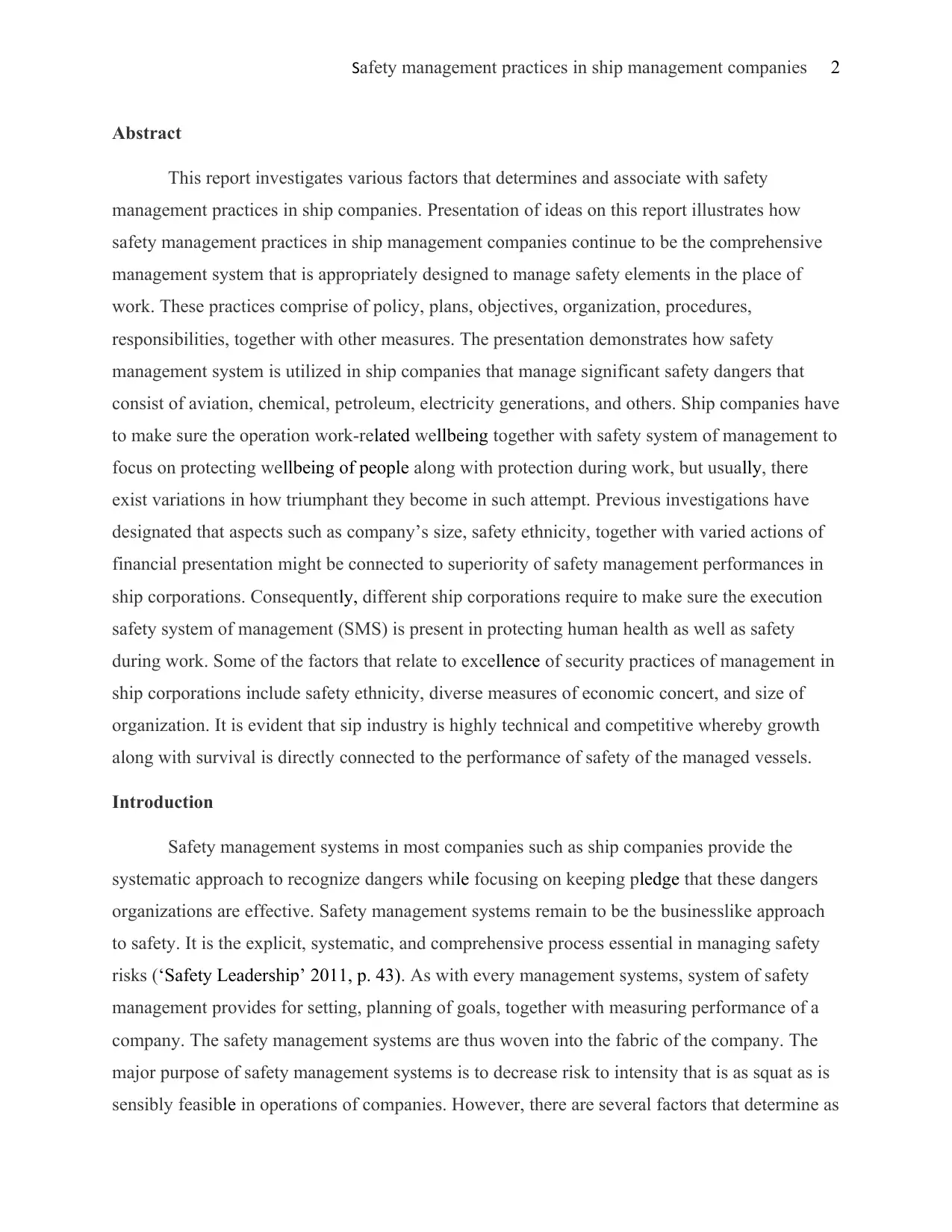
Safety management practices in ship management companies 2
Abstract
This report investigates various factors that determines and associate with safety
management practices in ship companies. Presentation of ideas on this report illustrates how
safety management practices in ship management companies continue to be the comprehensive
management system that is appropriately designed to manage safety elements in the place of
work. These practices comprise of policy, plans, objectives, organization, procedures,
responsibilities, together with other measures. The presentation demonstrates how safety
management system is utilized in ship companies that manage significant safety dangers that
consist of aviation, chemical, petroleum, electricity generations, and others. Ship companies have
to make sure the operation work-related wellbeing together with safety system of management to
focus on protecting wellbeing of people along with protection during work, but usually, there
exist variations in how triumphant they become in such attempt. Previous investigations have
designated that aspects such as company’s size, safety ethnicity, together with varied actions of
financial presentation might be connected to superiority of safety management performances in
ship corporations. Consequently, different ship corporations require to make sure the execution
safety system of management (SMS) is present in protecting human health as well as safety
during work. Some of the factors that relate to excellence of security practices of management in
ship corporations include safety ethnicity, diverse measures of economic concert, and size of
organization. It is evident that sip industry is highly technical and competitive whereby growth
along with survival is directly connected to the performance of safety of the managed vessels.
Introduction
Safety management systems in most companies such as ship companies provide the
systematic approach to recognize dangers while focusing on keeping pledge that these dangers
organizations are effective. Safety management systems remain to be the businesslike approach
to safety. It is the explicit, systematic, and comprehensive process essential in managing safety
risks (‘Safety Leadership’ 2011, p. 43). As with every management systems, system of safety
management provides for setting, planning of goals, together with measuring performance of a
company. The safety management systems are thus woven into the fabric of the company. The
major purpose of safety management systems is to decrease risk to intensity that is as squat as is
sensibly feasible in operations of companies. However, there are several factors that determine as
Abstract
This report investigates various factors that determines and associate with safety
management practices in ship companies. Presentation of ideas on this report illustrates how
safety management practices in ship management companies continue to be the comprehensive
management system that is appropriately designed to manage safety elements in the place of
work. These practices comprise of policy, plans, objectives, organization, procedures,
responsibilities, together with other measures. The presentation demonstrates how safety
management system is utilized in ship companies that manage significant safety dangers that
consist of aviation, chemical, petroleum, electricity generations, and others. Ship companies have
to make sure the operation work-related wellbeing together with safety system of management to
focus on protecting wellbeing of people along with protection during work, but usually, there
exist variations in how triumphant they become in such attempt. Previous investigations have
designated that aspects such as company’s size, safety ethnicity, together with varied actions of
financial presentation might be connected to superiority of safety management performances in
ship corporations. Consequently, different ship corporations require to make sure the execution
safety system of management (SMS) is present in protecting human health as well as safety
during work. Some of the factors that relate to excellence of security practices of management in
ship corporations include safety ethnicity, diverse measures of economic concert, and size of
organization. It is evident that sip industry is highly technical and competitive whereby growth
along with survival is directly connected to the performance of safety of the managed vessels.
Introduction
Safety management systems in most companies such as ship companies provide the
systematic approach to recognize dangers while focusing on keeping pledge that these dangers
organizations are effective. Safety management systems remain to be the businesslike approach
to safety. It is the explicit, systematic, and comprehensive process essential in managing safety
risks (‘Safety Leadership’ 2011, p. 43). As with every management systems, system of safety
management provides for setting, planning of goals, together with measuring performance of a
company. The safety management systems are thus woven into the fabric of the company. The
major purpose of safety management systems is to decrease risk to intensity that is as squat as is
sensibly feasible in operations of companies. However, there are several factors that determine as
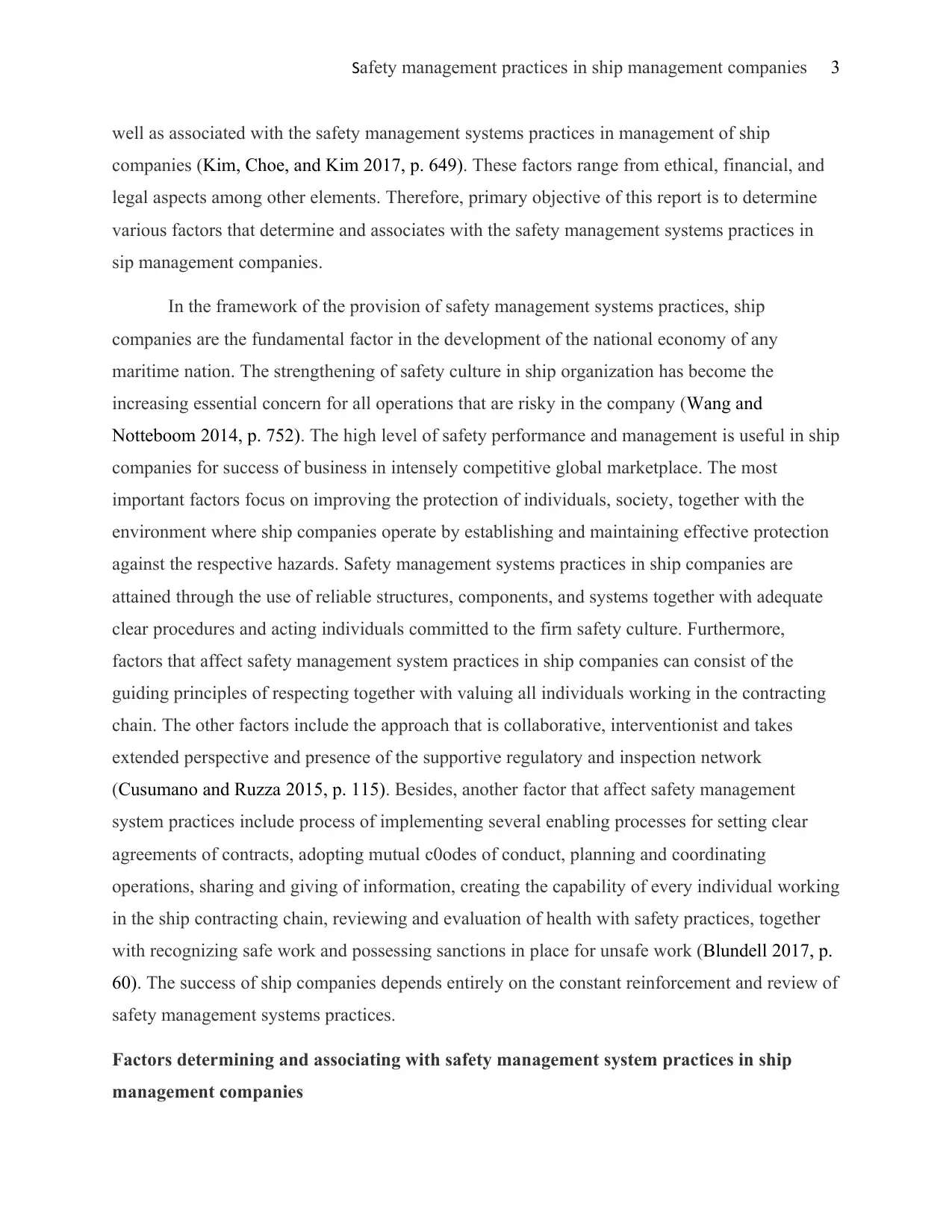
Safety management practices in ship management companies 3
well as associated with the safety management systems practices in management of ship
companies (Kim, Choe, and Kim 2017, p. 649). These factors range from ethical, financial, and
legal aspects among other elements. Therefore, primary objective of this report is to determine
various factors that determine and associates with the safety management systems practices in
sip management companies.
In the framework of the provision of safety management systems practices, ship
companies are the fundamental factor in the development of the national economy of any
maritime nation. The strengthening of safety culture in ship organization has become the
increasing essential concern for all operations that are risky in the company (Wang and
Notteboom 2014, p. 752). The high level of safety performance and management is useful in ship
companies for success of business in intensely competitive global marketplace. The most
important factors focus on improving the protection of individuals, society, together with the
environment where ship companies operate by establishing and maintaining effective protection
against the respective hazards. Safety management systems practices in ship companies are
attained through the use of reliable structures, components, and systems together with adequate
clear procedures and acting individuals committed to the firm safety culture. Furthermore,
factors that affect safety management system practices in ship companies can consist of the
guiding principles of respecting together with valuing all individuals working in the contracting
chain. The other factors include the approach that is collaborative, interventionist and takes
extended perspective and presence of the supportive regulatory and inspection network
(Cusumano and Ruzza 2015, p. 115). Besides, another factor that affect safety management
system practices include process of implementing several enabling processes for setting clear
agreements of contracts, adopting mutual c0odes of conduct, planning and coordinating
operations, sharing and giving of information, creating the capability of every individual working
in the ship contracting chain, reviewing and evaluation of health with safety practices, together
with recognizing safe work and possessing sanctions in place for unsafe work (Blundell 2017, p.
60). The success of ship companies depends entirely on the constant reinforcement and review of
safety management systems practices.
Factors determining and associating with safety management system practices in ship
management companies
well as associated with the safety management systems practices in management of ship
companies (Kim, Choe, and Kim 2017, p. 649). These factors range from ethical, financial, and
legal aspects among other elements. Therefore, primary objective of this report is to determine
various factors that determine and associates with the safety management systems practices in
sip management companies.
In the framework of the provision of safety management systems practices, ship
companies are the fundamental factor in the development of the national economy of any
maritime nation. The strengthening of safety culture in ship organization has become the
increasing essential concern for all operations that are risky in the company (Wang and
Notteboom 2014, p. 752). The high level of safety performance and management is useful in ship
companies for success of business in intensely competitive global marketplace. The most
important factors focus on improving the protection of individuals, society, together with the
environment where ship companies operate by establishing and maintaining effective protection
against the respective hazards. Safety management systems practices in ship companies are
attained through the use of reliable structures, components, and systems together with adequate
clear procedures and acting individuals committed to the firm safety culture. Furthermore,
factors that affect safety management system practices in ship companies can consist of the
guiding principles of respecting together with valuing all individuals working in the contracting
chain. The other factors include the approach that is collaborative, interventionist and takes
extended perspective and presence of the supportive regulatory and inspection network
(Cusumano and Ruzza 2015, p. 115). Besides, another factor that affect safety management
system practices include process of implementing several enabling processes for setting clear
agreements of contracts, adopting mutual c0odes of conduct, planning and coordinating
operations, sharing and giving of information, creating the capability of every individual working
in the ship contracting chain, reviewing and evaluation of health with safety practices, together
with recognizing safe work and possessing sanctions in place for unsafe work (Blundell 2017, p.
60). The success of ship companies depends entirely on the constant reinforcement and review of
safety management systems practices.
Factors determining and associating with safety management system practices in ship
management companies
⊘ This is a preview!⊘
Do you want full access?
Subscribe today to unlock all pages.

Trusted by 1+ million students worldwide
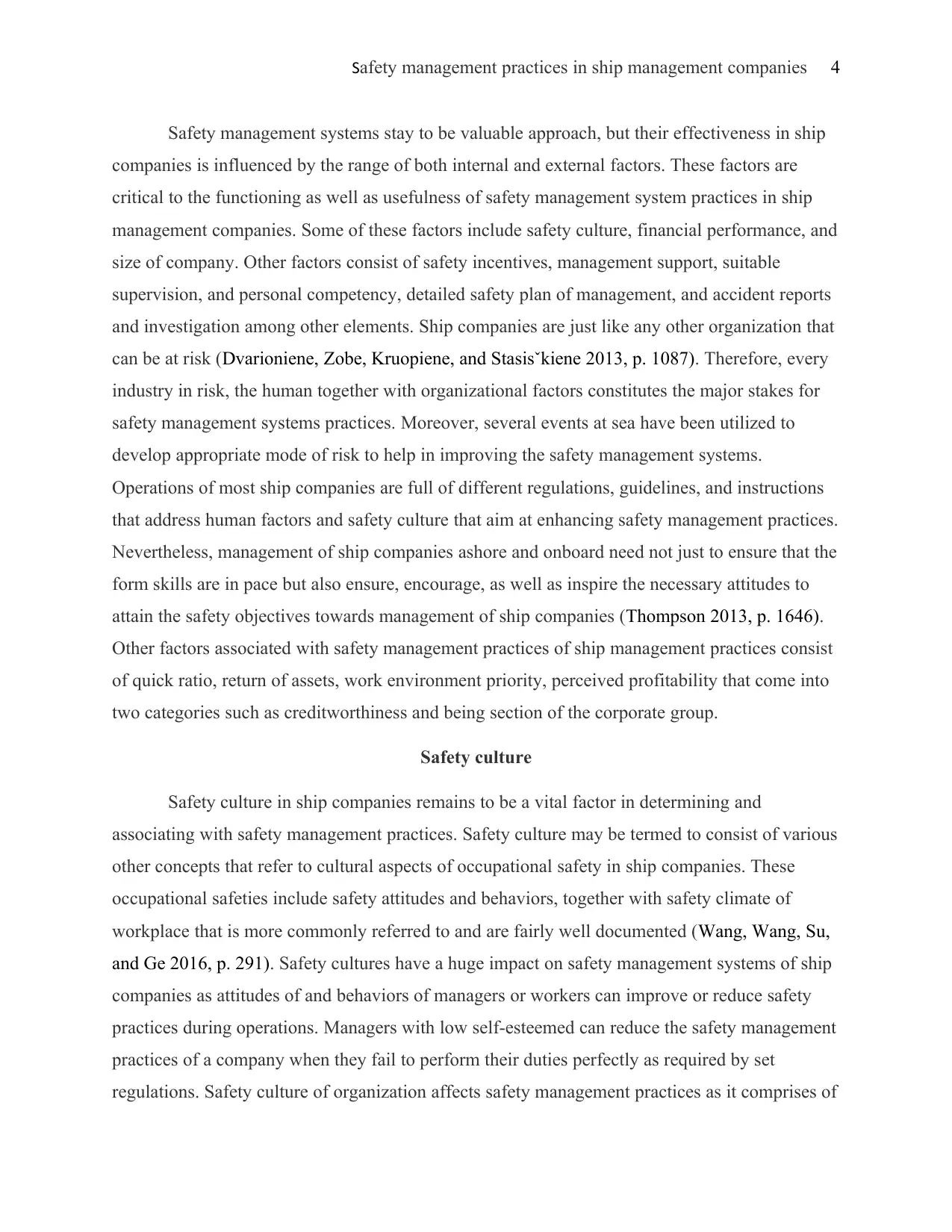
Safety management practices in ship management companies 4
Safety management systems stay to be valuable approach, but their effectiveness in ship
companies is influenced by the range of both internal and external factors. These factors are
critical to the functioning as well as usefulness of safety management system practices in ship
management companies. Some of these factors include safety culture, financial performance, and
size of company. Other factors consist of safety incentives, management support, suitable
supervision, and personal competency, detailed safety plan of management, and accident reports
and investigation among other elements. Ship companies are just like any other organization that
can be at risk (Dvarioniene, Zobe, Kruopiene, and Stasisˇkiene 2013, p. 1087). Therefore, every
industry in risk, the human together with organizational factors constitutes the major stakes for
safety management systems practices. Moreover, several events at sea have been utilized to
develop appropriate mode of risk to help in improving the safety management systems.
Operations of most ship companies are full of different regulations, guidelines, and instructions
that address human factors and safety culture that aim at enhancing safety management practices.
Nevertheless, management of ship companies ashore and onboard need not just to ensure that the
form skills are in pace but also ensure, encourage, as well as inspire the necessary attitudes to
attain the safety objectives towards management of ship companies (Thompson 2013, p. 1646).
Other factors associated with safety management practices of ship management practices consist
of quick ratio, return of assets, work environment priority, perceived profitability that come into
two categories such as creditworthiness and being section of the corporate group.
Safety culture
Safety culture in ship companies remains to be a vital factor in determining and
associating with safety management practices. Safety culture may be termed to consist of various
other concepts that refer to cultural aspects of occupational safety in ship companies. These
occupational safeties include safety attitudes and behaviors, together with safety climate of
workplace that is more commonly referred to and are fairly well documented (Wang, Wang, Su,
and Ge 2016, p. 291). Safety cultures have a huge impact on safety management systems of ship
companies as attitudes of and behaviors of managers or workers can improve or reduce safety
practices during operations. Managers with low self-esteemed can reduce the safety management
practices of a company when they fail to perform their duties perfectly as required by set
regulations. Safety culture of organization affects safety management practices as it comprises of
Safety management systems stay to be valuable approach, but their effectiveness in ship
companies is influenced by the range of both internal and external factors. These factors are
critical to the functioning as well as usefulness of safety management system practices in ship
management companies. Some of these factors include safety culture, financial performance, and
size of company. Other factors consist of safety incentives, management support, suitable
supervision, and personal competency, detailed safety plan of management, and accident reports
and investigation among other elements. Ship companies are just like any other organization that
can be at risk (Dvarioniene, Zobe, Kruopiene, and Stasisˇkiene 2013, p. 1087). Therefore, every
industry in risk, the human together with organizational factors constitutes the major stakes for
safety management systems practices. Moreover, several events at sea have been utilized to
develop appropriate mode of risk to help in improving the safety management systems.
Operations of most ship companies are full of different regulations, guidelines, and instructions
that address human factors and safety culture that aim at enhancing safety management practices.
Nevertheless, management of ship companies ashore and onboard need not just to ensure that the
form skills are in pace but also ensure, encourage, as well as inspire the necessary attitudes to
attain the safety objectives towards management of ship companies (Thompson 2013, p. 1646).
Other factors associated with safety management practices of ship management practices consist
of quick ratio, return of assets, work environment priority, perceived profitability that come into
two categories such as creditworthiness and being section of the corporate group.
Safety culture
Safety culture in ship companies remains to be a vital factor in determining and
associating with safety management practices. Safety culture may be termed to consist of various
other concepts that refer to cultural aspects of occupational safety in ship companies. These
occupational safeties include safety attitudes and behaviors, together with safety climate of
workplace that is more commonly referred to and are fairly well documented (Wang, Wang, Su,
and Ge 2016, p. 291). Safety cultures have a huge impact on safety management systems of ship
companies as attitudes of and behaviors of managers or workers can improve or reduce safety
practices during operations. Managers with low self-esteemed can reduce the safety management
practices of a company when they fail to perform their duties perfectly as required by set
regulations. Safety culture of organization affects safety management practices as it comprises of
Paraphrase This Document
Need a fresh take? Get an instant paraphrase of this document with our AI Paraphraser
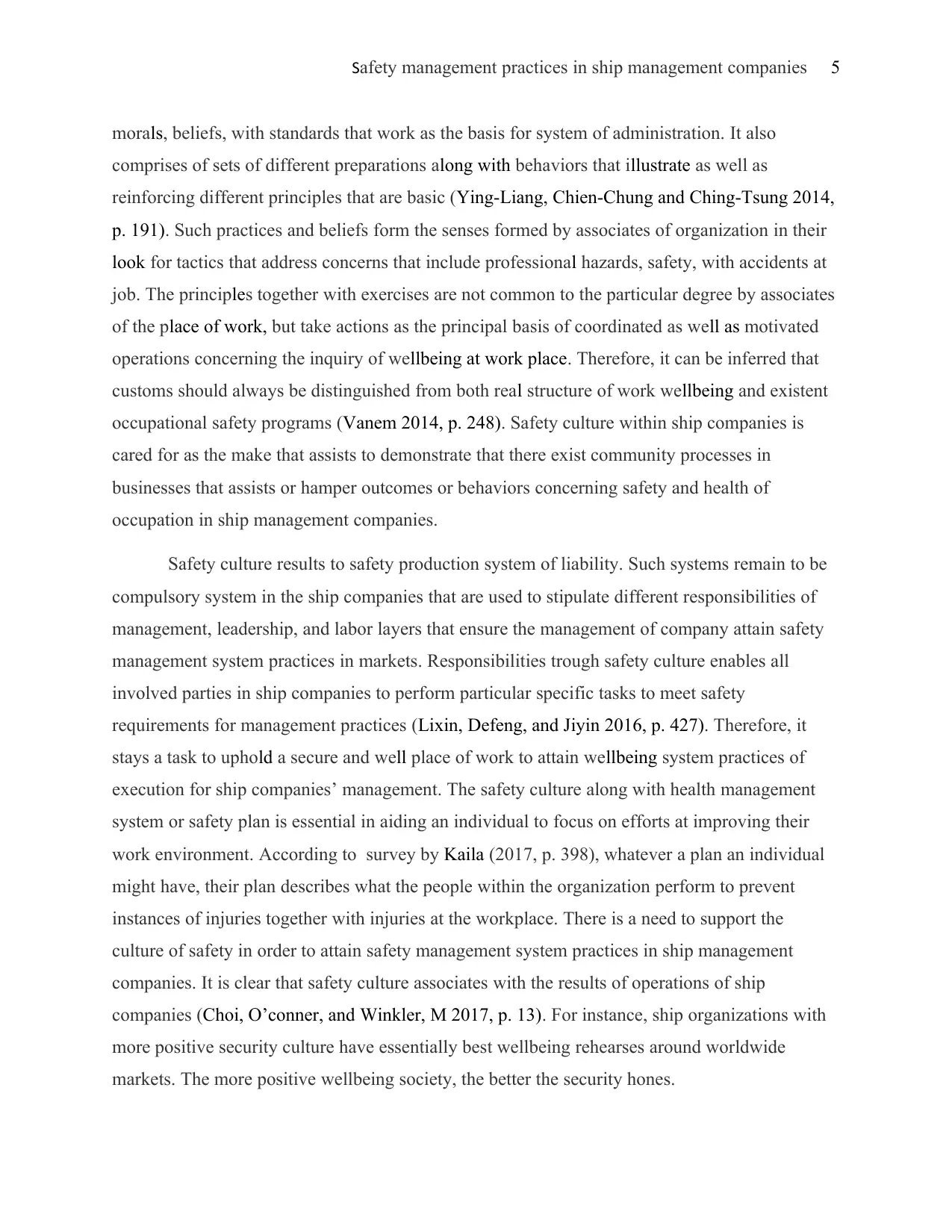
Safety management practices in ship management companies 5
morals, beliefs, with standards that work as the basis for system of administration. It also
comprises of sets of different preparations along with behaviors that illustrate as well as
reinforcing different principles that are basic (Ying-Liang, Chien-Chung and Ching-Tsung 2014,
p. 191). Such practices and beliefs form the senses formed by associates of organization in their
look for tactics that address concerns that include professional hazards, safety, with accidents at
job. The principles together with exercises are not common to the particular degree by associates
of the place of work, but take actions as the principal basis of coordinated as well as motivated
operations concerning the inquiry of wellbeing at work place. Therefore, it can be inferred that
customs should always be distinguished from both real structure of work wellbeing and existent
occupational safety programs (Vanem 2014, p. 248). Safety culture within ship companies is
cared for as the make that assists to demonstrate that there exist community processes in
businesses that assists or hamper outcomes or behaviors concerning safety and health of
occupation in ship management companies.
Safety culture results to safety production system of liability. Such systems remain to be
compulsory system in the ship companies that are used to stipulate different responsibilities of
management, leadership, and labor layers that ensure the management of company attain safety
management system practices in markets. Responsibilities trough safety culture enables all
involved parties in ship companies to perform particular specific tasks to meet safety
requirements for management practices (Lixin, Defeng, and Jiyin 2016, p. 427). Therefore, it
stays a task to uphold a secure and well place of work to attain wellbeing system practices of
execution for ship companies’ management. The safety culture along with health management
system or safety plan is essential in aiding an individual to focus on efforts at improving their
work environment. According to survey by Kaila (2017, p. 398), whatever a plan an individual
might have, their plan describes what the people within the organization perform to prevent
instances of injuries together with injuries at the workplace. There is a need to support the
culture of safety in order to attain safety management system practices in ship management
companies. It is clear that safety culture associates with the results of operations of ship
companies (Choi, O’conner, and Winkler, M 2017, p. 13). For instance, ship organizations with
more positive security culture have essentially best wellbeing rehearses around worldwide
markets. The more positive wellbeing society, the better the security hones.
morals, beliefs, with standards that work as the basis for system of administration. It also
comprises of sets of different preparations along with behaviors that illustrate as well as
reinforcing different principles that are basic (Ying-Liang, Chien-Chung and Ching-Tsung 2014,
p. 191). Such practices and beliefs form the senses formed by associates of organization in their
look for tactics that address concerns that include professional hazards, safety, with accidents at
job. The principles together with exercises are not common to the particular degree by associates
of the place of work, but take actions as the principal basis of coordinated as well as motivated
operations concerning the inquiry of wellbeing at work place. Therefore, it can be inferred that
customs should always be distinguished from both real structure of work wellbeing and existent
occupational safety programs (Vanem 2014, p. 248). Safety culture within ship companies is
cared for as the make that assists to demonstrate that there exist community processes in
businesses that assists or hamper outcomes or behaviors concerning safety and health of
occupation in ship management companies.
Safety culture results to safety production system of liability. Such systems remain to be
compulsory system in the ship companies that are used to stipulate different responsibilities of
management, leadership, and labor layers that ensure the management of company attain safety
management system practices in markets. Responsibilities trough safety culture enables all
involved parties in ship companies to perform particular specific tasks to meet safety
requirements for management practices (Lixin, Defeng, and Jiyin 2016, p. 427). Therefore, it
stays a task to uphold a secure and well place of work to attain wellbeing system practices of
execution for ship companies’ management. The safety culture along with health management
system or safety plan is essential in aiding an individual to focus on efforts at improving their
work environment. According to survey by Kaila (2017, p. 398), whatever a plan an individual
might have, their plan describes what the people within the organization perform to prevent
instances of injuries together with injuries at the workplace. There is a need to support the
culture of safety in order to attain safety management system practices in ship management
companies. It is clear that safety culture associates with the results of operations of ship
companies (Choi, O’conner, and Winkler, M 2017, p. 13). For instance, ship organizations with
more positive security culture have essentially best wellbeing rehearses around worldwide
markets. The more positive wellbeing society, the better the security hones.
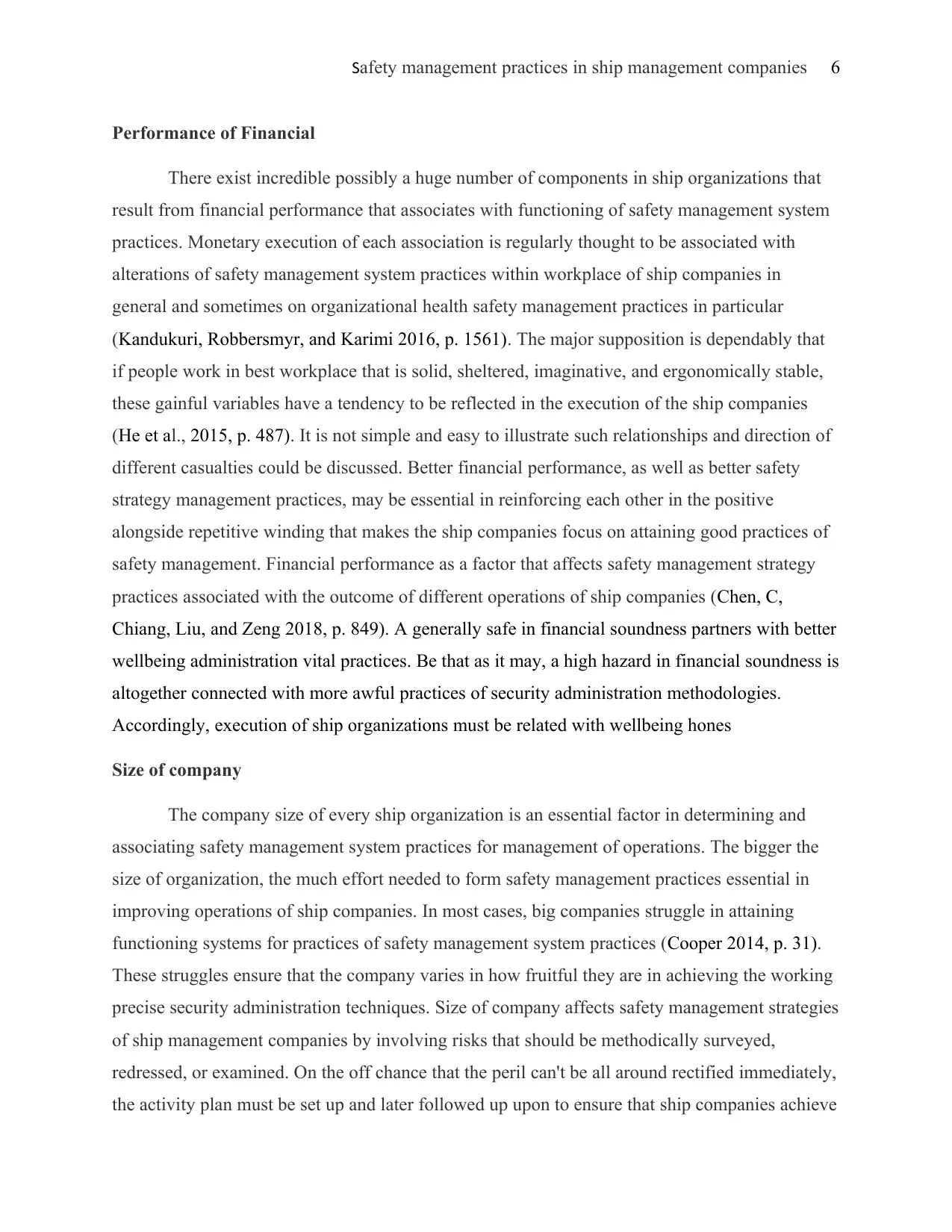
Safety management practices in ship management companies 6
Performance of Financial
There exist incredible possibly a huge number of components in ship organizations that
result from financial performance that associates with functioning of safety management system
practices. Monetary execution of each association is regularly thought to be associated with
alterations of safety management system practices within workplace of ship companies in
general and sometimes on organizational health safety management practices in particular
(Kandukuri, Robbersmyr, and Karimi 2016, p. 1561). The major supposition is dependably that
if people work in best workplace that is solid, sheltered, imaginative, and ergonomically stable,
these gainful variables have a tendency to be reflected in the execution of the ship companies
(He et al., 2015, p. 487). It is not simple and easy to illustrate such relationships and direction of
different casualties could be discussed. Better financial performance, as well as better safety
strategy management practices, may be essential in reinforcing each other in the positive
alongside repetitive winding that makes the ship companies focus on attaining good practices of
safety management. Financial performance as a factor that affects safety management strategy
practices associated with the outcome of different operations of ship companies (Chen, C,
Chiang, Liu, and Zeng 2018, p. 849). A generally safe in financial soundness partners with better
wellbeing administration vital practices. Be that as it may, a high hazard in financial soundness is
altogether connected with more awful practices of security administration methodologies.
Accordingly, execution of ship organizations must be related with wellbeing hones
Size of company
The company size of every ship organization is an essential factor in determining and
associating safety management system practices for management of operations. The bigger the
size of organization, the much effort needed to form safety management practices essential in
improving operations of ship companies. In most cases, big companies struggle in attaining
functioning systems for practices of safety management system practices (Cooper 2014, p. 31).
These struggles ensure that the company varies in how fruitful they are in achieving the working
precise security administration techniques. Size of company affects safety management strategies
of ship management companies by involving risks that should be methodically surveyed,
redressed, or examined. On the off chance that the peril can't be all around rectified immediately,
the activity plan must be set up and later followed up upon to ensure that ship companies achieve
Performance of Financial
There exist incredible possibly a huge number of components in ship organizations that
result from financial performance that associates with functioning of safety management system
practices. Monetary execution of each association is regularly thought to be associated with
alterations of safety management system practices within workplace of ship companies in
general and sometimes on organizational health safety management practices in particular
(Kandukuri, Robbersmyr, and Karimi 2016, p. 1561). The major supposition is dependably that
if people work in best workplace that is solid, sheltered, imaginative, and ergonomically stable,
these gainful variables have a tendency to be reflected in the execution of the ship companies
(He et al., 2015, p. 487). It is not simple and easy to illustrate such relationships and direction of
different casualties could be discussed. Better financial performance, as well as better safety
strategy management practices, may be essential in reinforcing each other in the positive
alongside repetitive winding that makes the ship companies focus on attaining good practices of
safety management. Financial performance as a factor that affects safety management strategy
practices associated with the outcome of different operations of ship companies (Chen, C,
Chiang, Liu, and Zeng 2018, p. 849). A generally safe in financial soundness partners with better
wellbeing administration vital practices. Be that as it may, a high hazard in financial soundness is
altogether connected with more awful practices of security administration methodologies.
Accordingly, execution of ship organizations must be related with wellbeing hones
Size of company
The company size of every ship organization is an essential factor in determining and
associating safety management system practices for management of operations. The bigger the
size of organization, the much effort needed to form safety management practices essential in
improving operations of ship companies. In most cases, big companies struggle in attaining
functioning systems for practices of safety management system practices (Cooper 2014, p. 31).
These struggles ensure that the company varies in how fruitful they are in achieving the working
precise security administration techniques. Size of company affects safety management strategies
of ship management companies by involving risks that should be methodically surveyed,
redressed, or examined. On the off chance that the peril can't be all around rectified immediately,
the activity plan must be set up and later followed up upon to ensure that ship companies achieve
⊘ This is a preview!⊘
Do you want full access?
Subscribe today to unlock all pages.

Trusted by 1+ million students worldwide
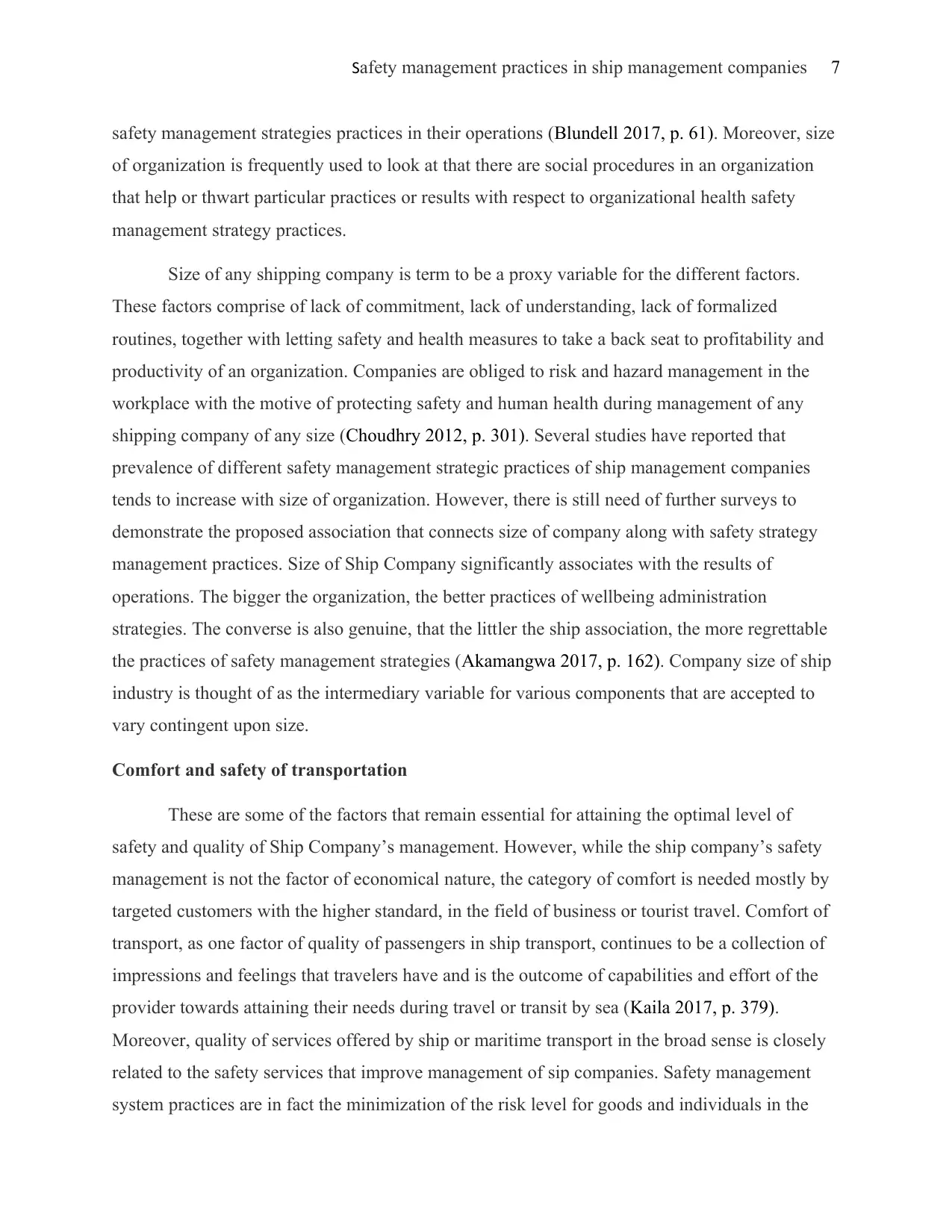
Safety management practices in ship management companies 7
safety management strategies practices in their operations (Blundell 2017, p. 61). Moreover, size
of organization is frequently used to look at that there are social procedures in an organization
that help or thwart particular practices or results with respect to organizational health safety
management strategy practices.
Size of any shipping company is term to be a proxy variable for the different factors.
These factors comprise of lack of commitment, lack of understanding, lack of formalized
routines, together with letting safety and health measures to take a back seat to profitability and
productivity of an organization. Companies are obliged to risk and hazard management in the
workplace with the motive of protecting safety and human health during management of any
shipping company of any size (Choudhry 2012, p. 301). Several studies have reported that
prevalence of different safety management strategic practices of ship management companies
tends to increase with size of organization. However, there is still need of further surveys to
demonstrate the proposed association that connects size of company along with safety strategy
management practices. Size of Ship Company significantly associates with the results of
operations. The bigger the organization, the better practices of wellbeing administration
strategies. The converse is also genuine, that the littler the ship association, the more regrettable
the practices of safety management strategies (Akamangwa 2017, p. 162). Company size of ship
industry is thought of as the intermediary variable for various components that are accepted to
vary contingent upon size.
Comfort and safety of transportation
These are some of the factors that remain essential for attaining the optimal level of
safety and quality of Ship Company’s management. However, while the ship company’s safety
management is not the factor of economical nature, the category of comfort is needed mostly by
targeted customers with the higher standard, in the field of business or tourist travel. Comfort of
transport, as one factor of quality of passengers in ship transport, continues to be a collection of
impressions and feelings that travelers have and is the outcome of capabilities and effort of the
provider towards attaining their needs during travel or transit by sea (Kaila 2017, p. 379).
Moreover, quality of services offered by ship or maritime transport in the broad sense is closely
related to the safety services that improve management of sip companies. Safety management
system practices are in fact the minimization of the risk level for goods and individuals in the
safety management strategies practices in their operations (Blundell 2017, p. 61). Moreover, size
of organization is frequently used to look at that there are social procedures in an organization
that help or thwart particular practices or results with respect to organizational health safety
management strategy practices.
Size of any shipping company is term to be a proxy variable for the different factors.
These factors comprise of lack of commitment, lack of understanding, lack of formalized
routines, together with letting safety and health measures to take a back seat to profitability and
productivity of an organization. Companies are obliged to risk and hazard management in the
workplace with the motive of protecting safety and human health during management of any
shipping company of any size (Choudhry 2012, p. 301). Several studies have reported that
prevalence of different safety management strategic practices of ship management companies
tends to increase with size of organization. However, there is still need of further surveys to
demonstrate the proposed association that connects size of company along with safety strategy
management practices. Size of Ship Company significantly associates with the results of
operations. The bigger the organization, the better practices of wellbeing administration
strategies. The converse is also genuine, that the littler the ship association, the more regrettable
the practices of safety management strategies (Akamangwa 2017, p. 162). Company size of ship
industry is thought of as the intermediary variable for various components that are accepted to
vary contingent upon size.
Comfort and safety of transportation
These are some of the factors that remain essential for attaining the optimal level of
safety and quality of Ship Company’s management. However, while the ship company’s safety
management is not the factor of economical nature, the category of comfort is needed mostly by
targeted customers with the higher standard, in the field of business or tourist travel. Comfort of
transport, as one factor of quality of passengers in ship transport, continues to be a collection of
impressions and feelings that travelers have and is the outcome of capabilities and effort of the
provider towards attaining their needs during travel or transit by sea (Kaila 2017, p. 379).
Moreover, quality of services offered by ship or maritime transport in the broad sense is closely
related to the safety services that improve management of sip companies. Safety management
system practices are in fact the minimization of the risk level for goods and individuals in the
Paraphrase This Document
Need a fresh take? Get an instant paraphrase of this document with our AI Paraphraser
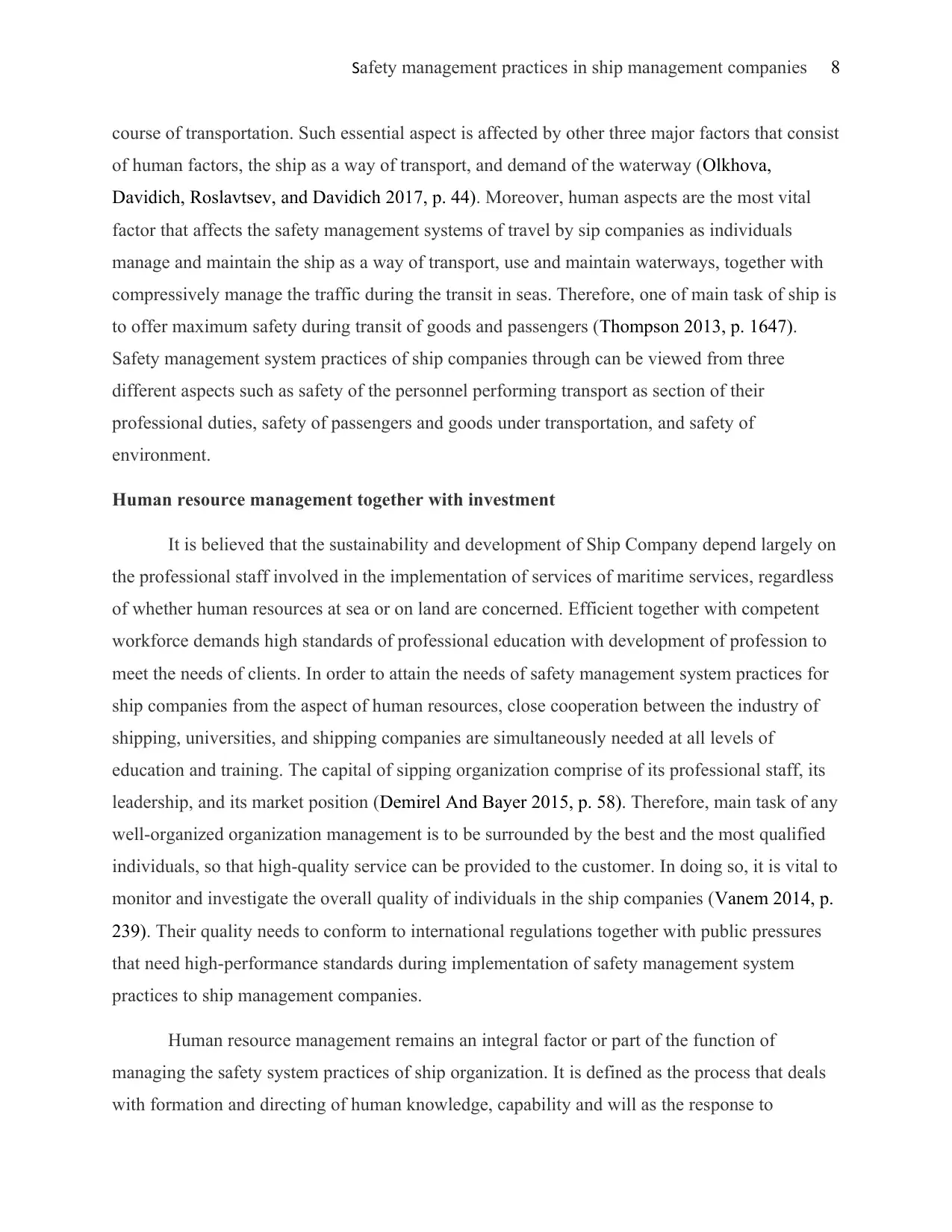
Safety management practices in ship management companies 8
course of transportation. Such essential aspect is affected by other three major factors that consist
of human factors, the ship as a way of transport, and demand of the waterway (Olkhova,
Davidich, Roslavtsev, and Davidich 2017, p. 44). Moreover, human aspects are the most vital
factor that affects the safety management systems of travel by sip companies as individuals
manage and maintain the ship as a way of transport, use and maintain waterways, together with
compressively manage the traffic during the transit in seas. Therefore, one of main task of ship is
to offer maximum safety during transit of goods and passengers (Thompson 2013, p. 1647).
Safety management system practices of ship companies through can be viewed from three
different aspects such as safety of the personnel performing transport as section of their
professional duties, safety of passengers and goods under transportation, and safety of
environment.
Human resource management together with investment
It is believed that the sustainability and development of Ship Company depend largely on
the professional staff involved in the implementation of services of maritime services, regardless
of whether human resources at sea or on land are concerned. Efficient together with competent
workforce demands high standards of professional education with development of profession to
meet the needs of clients. In order to attain the needs of safety management system practices for
ship companies from the aspect of human resources, close cooperation between the industry of
shipping, universities, and shipping companies are simultaneously needed at all levels of
education and training. The capital of sipping organization comprise of its professional staff, its
leadership, and its market position (Demirel And Bayer 2015, p. 58). Therefore, main task of any
well-organized organization management is to be surrounded by the best and the most qualified
individuals, so that high-quality service can be provided to the customer. In doing so, it is vital to
monitor and investigate the overall quality of individuals in the ship companies (Vanem 2014, p.
239). Their quality needs to conform to international regulations together with public pressures
that need high-performance standards during implementation of safety management system
practices to ship management companies.
Human resource management remains an integral factor or part of the function of
managing the safety system practices of ship organization. It is defined as the process that deals
with formation and directing of human knowledge, capability and will as the response to
course of transportation. Such essential aspect is affected by other three major factors that consist
of human factors, the ship as a way of transport, and demand of the waterway (Olkhova,
Davidich, Roslavtsev, and Davidich 2017, p. 44). Moreover, human aspects are the most vital
factor that affects the safety management systems of travel by sip companies as individuals
manage and maintain the ship as a way of transport, use and maintain waterways, together with
compressively manage the traffic during the transit in seas. Therefore, one of main task of ship is
to offer maximum safety during transit of goods and passengers (Thompson 2013, p. 1647).
Safety management system practices of ship companies through can be viewed from three
different aspects such as safety of the personnel performing transport as section of their
professional duties, safety of passengers and goods under transportation, and safety of
environment.
Human resource management together with investment
It is believed that the sustainability and development of Ship Company depend largely on
the professional staff involved in the implementation of services of maritime services, regardless
of whether human resources at sea or on land are concerned. Efficient together with competent
workforce demands high standards of professional education with development of profession to
meet the needs of clients. In order to attain the needs of safety management system practices for
ship companies from the aspect of human resources, close cooperation between the industry of
shipping, universities, and shipping companies are simultaneously needed at all levels of
education and training. The capital of sipping organization comprise of its professional staff, its
leadership, and its market position (Demirel And Bayer 2015, p. 58). Therefore, main task of any
well-organized organization management is to be surrounded by the best and the most qualified
individuals, so that high-quality service can be provided to the customer. In doing so, it is vital to
monitor and investigate the overall quality of individuals in the ship companies (Vanem 2014, p.
239). Their quality needs to conform to international regulations together with public pressures
that need high-performance standards during implementation of safety management system
practices to ship management companies.
Human resource management remains an integral factor or part of the function of
managing the safety system practices of ship organization. It is defined as the process that deals
with formation and directing of human knowledge, capability and will as the response to
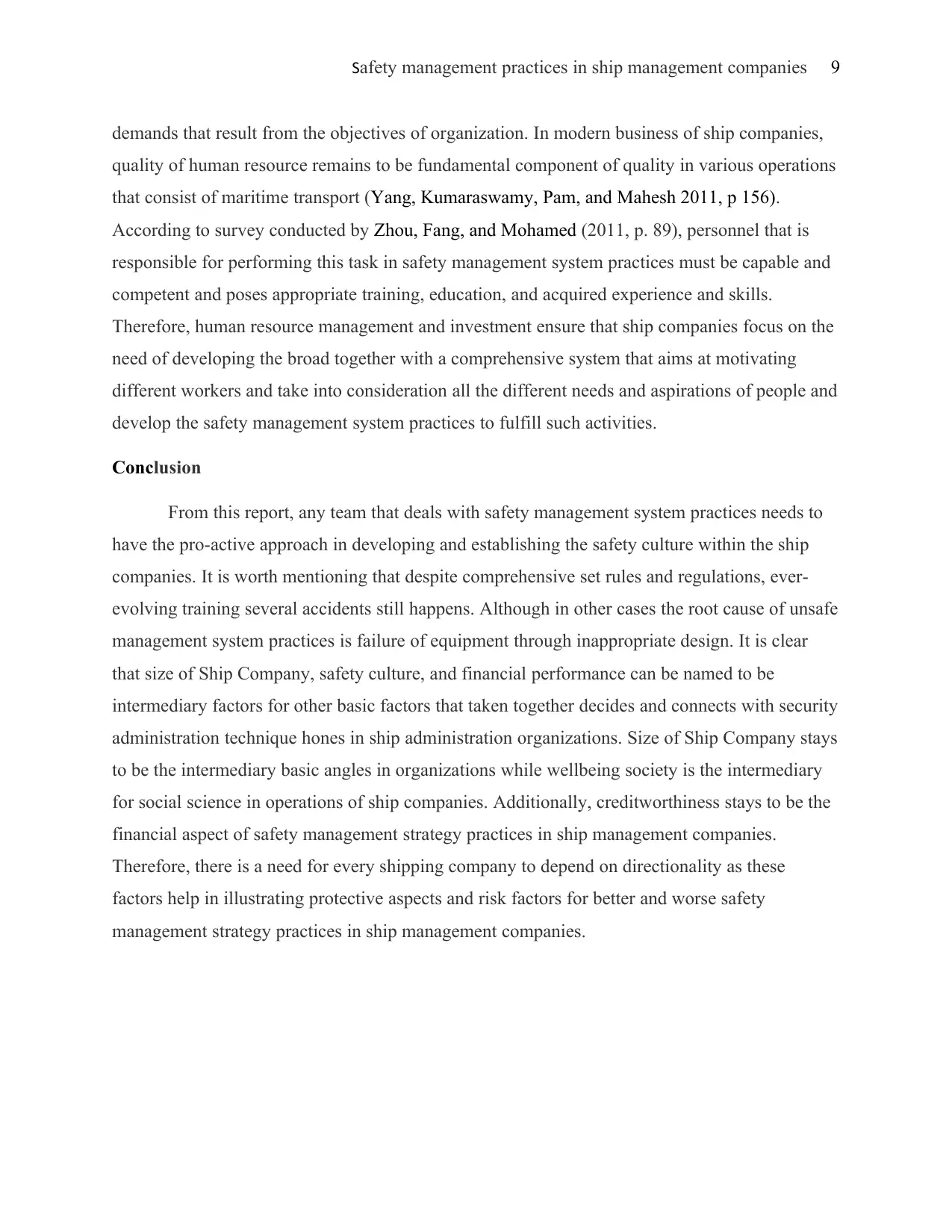
Safety management practices in ship management companies 9
demands that result from the objectives of organization. In modern business of ship companies,
quality of human resource remains to be fundamental component of quality in various operations
that consist of maritime transport (Yang, Kumaraswamy, Pam, and Mahesh 2011, p 156).
According to survey conducted by Zhou, Fang, and Mohamed (2011, p. 89), personnel that is
responsible for performing this task in safety management system practices must be capable and
competent and poses appropriate training, education, and acquired experience and skills.
Therefore, human resource management and investment ensure that ship companies focus on the
need of developing the broad together with a comprehensive system that aims at motivating
different workers and take into consideration all the different needs and aspirations of people and
develop the safety management system practices to fulfill such activities.
Conclusion
From this report, any team that deals with safety management system practices needs to
have the pro-active approach in developing and establishing the safety culture within the ship
companies. It is worth mentioning that despite comprehensive set rules and regulations, ever-
evolving training several accidents still happens. Although in other cases the root cause of unsafe
management system practices is failure of equipment through inappropriate design. It is clear
that size of Ship Company, safety culture, and financial performance can be named to be
intermediary factors for other basic factors that taken together decides and connects with security
administration technique hones in ship administration organizations. Size of Ship Company stays
to be the intermediary basic angles in organizations while wellbeing society is the intermediary
for social science in operations of ship companies. Additionally, creditworthiness stays to be the
financial aspect of safety management strategy practices in ship management companies.
Therefore, there is a need for every shipping company to depend on directionality as these
factors help in illustrating protective aspects and risk factors for better and worse safety
management strategy practices in ship management companies.
demands that result from the objectives of organization. In modern business of ship companies,
quality of human resource remains to be fundamental component of quality in various operations
that consist of maritime transport (Yang, Kumaraswamy, Pam, and Mahesh 2011, p 156).
According to survey conducted by Zhou, Fang, and Mohamed (2011, p. 89), personnel that is
responsible for performing this task in safety management system practices must be capable and
competent and poses appropriate training, education, and acquired experience and skills.
Therefore, human resource management and investment ensure that ship companies focus on the
need of developing the broad together with a comprehensive system that aims at motivating
different workers and take into consideration all the different needs and aspirations of people and
develop the safety management system practices to fulfill such activities.
Conclusion
From this report, any team that deals with safety management system practices needs to
have the pro-active approach in developing and establishing the safety culture within the ship
companies. It is worth mentioning that despite comprehensive set rules and regulations, ever-
evolving training several accidents still happens. Although in other cases the root cause of unsafe
management system practices is failure of equipment through inappropriate design. It is clear
that size of Ship Company, safety culture, and financial performance can be named to be
intermediary factors for other basic factors that taken together decides and connects with security
administration technique hones in ship administration organizations. Size of Ship Company stays
to be the intermediary basic angles in organizations while wellbeing society is the intermediary
for social science in operations of ship companies. Additionally, creditworthiness stays to be the
financial aspect of safety management strategy practices in ship management companies.
Therefore, there is a need for every shipping company to depend on directionality as these
factors help in illustrating protective aspects and risk factors for better and worse safety
management strategy practices in ship management companies.
⊘ This is a preview!⊘
Do you want full access?
Subscribe today to unlock all pages.

Trusted by 1+ million students worldwide
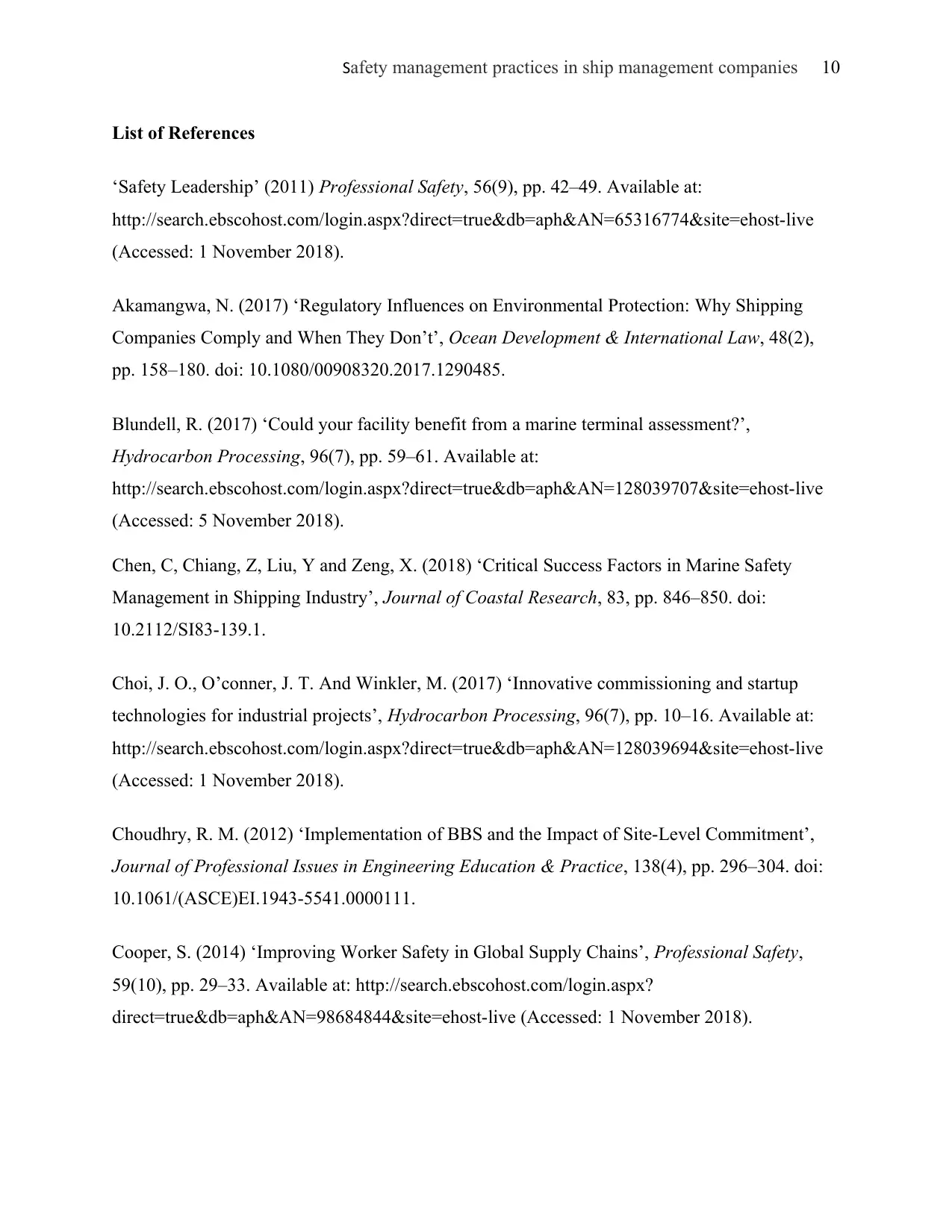
Safety management practices in ship management companies 10
List of References
‘Safety Leadership’ (2011) Professional Safety, 56(9), pp. 42–49. Available at:
http://search.ebscohost.com/login.aspx?direct=true&db=aph&AN=65316774&site=ehost-live
(Accessed: 1 November 2018).
Akamangwa, N. (2017) ‘Regulatory Influences on Environmental Protection: Why Shipping
Companies Comply and When They Don’t’, Ocean Development & International Law, 48(2),
pp. 158–180. doi: 10.1080/00908320.2017.1290485.
Blundell, R. (2017) ‘Could your facility benefit from a marine terminal assessment?’,
Hydrocarbon Processing, 96(7), pp. 59–61. Available at:
http://search.ebscohost.com/login.aspx?direct=true&db=aph&AN=128039707&site=ehost-live
(Accessed: 5 November 2018).
Chen, C, Chiang, Z, Liu, Y and Zeng, X. (2018) ‘Critical Success Factors in Marine Safety
Management in Shipping Industry’, Journal of Coastal Research, 83, pp. 846–850. doi:
10.2112/SI83-139.1.
Choi, J. O., O’conner, J. T. And Winkler, M. (2017) ‘Innovative commissioning and startup
technologies for industrial projects’, Hydrocarbon Processing, 96(7), pp. 10–16. Available at:
http://search.ebscohost.com/login.aspx?direct=true&db=aph&AN=128039694&site=ehost-live
(Accessed: 1 November 2018).
Choudhry, R. M. (2012) ‘Implementation of BBS and the Impact of Site-Level Commitment’,
Journal of Professional Issues in Engineering Education & Practice, 138(4), pp. 296–304. doi:
10.1061/(ASCE)EI.1943-5541.0000111.
Cooper, S. (2014) ‘Improving Worker Safety in Global Supply Chains’, Professional Safety,
59(10), pp. 29–33. Available at: http://search.ebscohost.com/login.aspx?
direct=true&db=aph&AN=98684844&site=ehost-live (Accessed: 1 November 2018).
List of References
‘Safety Leadership’ (2011) Professional Safety, 56(9), pp. 42–49. Available at:
http://search.ebscohost.com/login.aspx?direct=true&db=aph&AN=65316774&site=ehost-live
(Accessed: 1 November 2018).
Akamangwa, N. (2017) ‘Regulatory Influences on Environmental Protection: Why Shipping
Companies Comply and When They Don’t’, Ocean Development & International Law, 48(2),
pp. 158–180. doi: 10.1080/00908320.2017.1290485.
Blundell, R. (2017) ‘Could your facility benefit from a marine terminal assessment?’,
Hydrocarbon Processing, 96(7), pp. 59–61. Available at:
http://search.ebscohost.com/login.aspx?direct=true&db=aph&AN=128039707&site=ehost-live
(Accessed: 5 November 2018).
Chen, C, Chiang, Z, Liu, Y and Zeng, X. (2018) ‘Critical Success Factors in Marine Safety
Management in Shipping Industry’, Journal of Coastal Research, 83, pp. 846–850. doi:
10.2112/SI83-139.1.
Choi, J. O., O’conner, J. T. And Winkler, M. (2017) ‘Innovative commissioning and startup
technologies for industrial projects’, Hydrocarbon Processing, 96(7), pp. 10–16. Available at:
http://search.ebscohost.com/login.aspx?direct=true&db=aph&AN=128039694&site=ehost-live
(Accessed: 1 November 2018).
Choudhry, R. M. (2012) ‘Implementation of BBS and the Impact of Site-Level Commitment’,
Journal of Professional Issues in Engineering Education & Practice, 138(4), pp. 296–304. doi:
10.1061/(ASCE)EI.1943-5541.0000111.
Cooper, S. (2014) ‘Improving Worker Safety in Global Supply Chains’, Professional Safety,
59(10), pp. 29–33. Available at: http://search.ebscohost.com/login.aspx?
direct=true&db=aph&AN=98684844&site=ehost-live (Accessed: 1 November 2018).
Paraphrase This Document
Need a fresh take? Get an instant paraphrase of this document with our AI Paraphraser
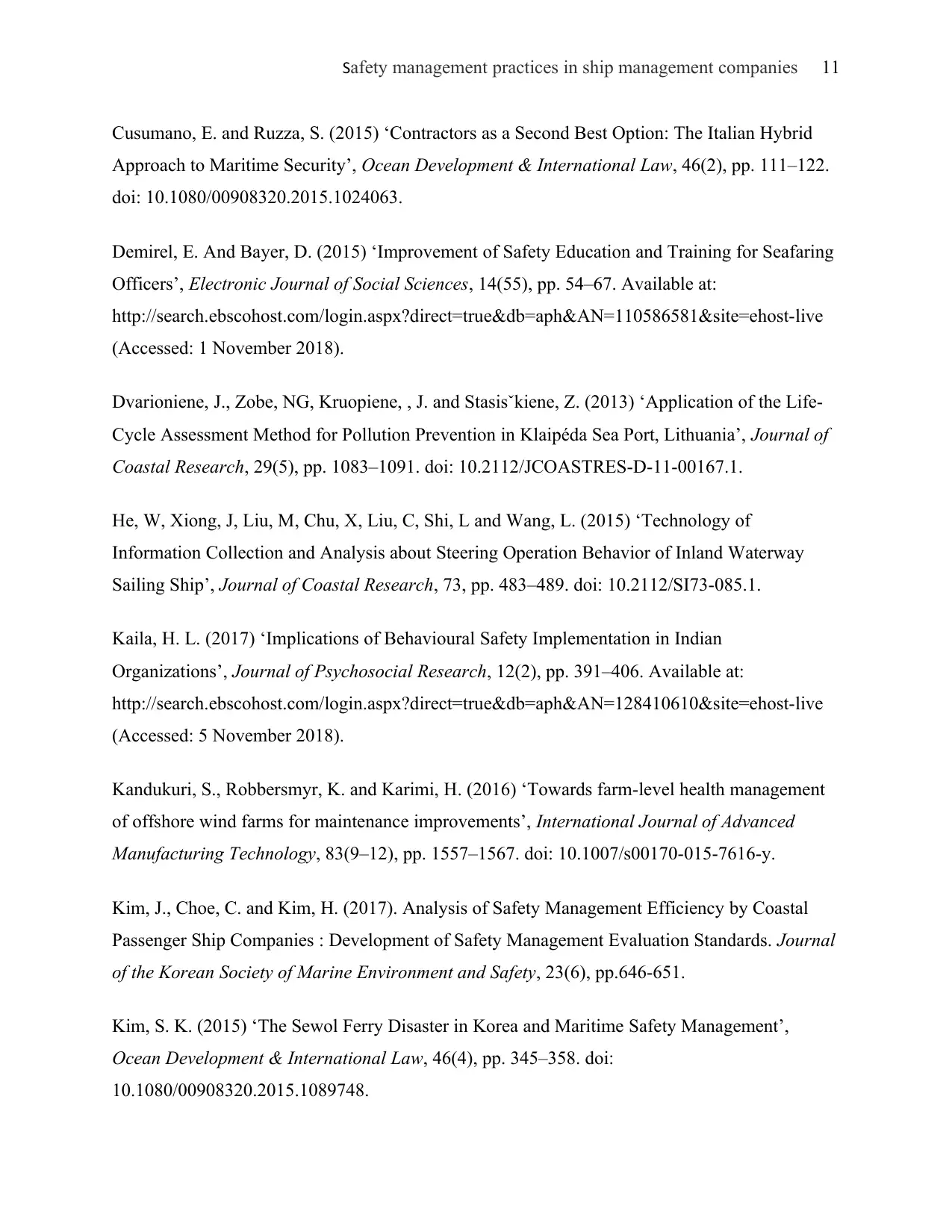
Safety management practices in ship management companies 11
Cusumano, E. and Ruzza, S. (2015) ‘Contractors as a Second Best Option: The Italian Hybrid
Approach to Maritime Security’, Ocean Development & International Law, 46(2), pp. 111–122.
doi: 10.1080/00908320.2015.1024063.
Demirel, E. And Bayer, D. (2015) ‘Improvement of Safety Education and Training for Seafaring
Officers’, Electronic Journal of Social Sciences, 14(55), pp. 54–67. Available at:
http://search.ebscohost.com/login.aspx?direct=true&db=aph&AN=110586581&site=ehost-live
(Accessed: 1 November 2018).
Dvarioniene, J., Zobe, NG, Kruopiene, , J. and Stasisˇkiene, Z. (2013) ‘Application of the Life-
Cycle Assessment Method for Pollution Prevention in Klaipéda Sea Port, Lithuania’, Journal of
Coastal Research, 29(5), pp. 1083–1091. doi: 10.2112/JCOASTRES-D-11-00167.1.
He, W, Xiong, J, Liu, M, Chu, X, Liu, C, Shi, L and Wang, L. (2015) ‘Technology of
Information Collection and Analysis about Steering Operation Behavior of Inland Waterway
Sailing Ship’, Journal of Coastal Research, 73, pp. 483–489. doi: 10.2112/SI73-085.1.
Kaila, H. L. (2017) ‘Implications of Behavioural Safety Implementation in Indian
Organizations’, Journal of Psychosocial Research, 12(2), pp. 391–406. Available at:
http://search.ebscohost.com/login.aspx?direct=true&db=aph&AN=128410610&site=ehost-live
(Accessed: 5 November 2018).
Kandukuri, S., Robbersmyr, K. and Karimi, H. (2016) ‘Towards farm-level health management
of offshore wind farms for maintenance improvements’, International Journal of Advanced
Manufacturing Technology, 83(9–12), pp. 1557–1567. doi: 10.1007/s00170-015-7616-y.
Kim, J., Choe, C. and Kim, H. (2017). Analysis of Safety Management Efficiency by Coastal
Passenger Ship Companies : Development of Safety Management Evaluation Standards. Journal
of the Korean Society of Marine Environment and Safety, 23(6), pp.646-651.
Kim, S. K. (2015) ‘The Sewol Ferry Disaster in Korea and Maritime Safety Management’,
Ocean Development & International Law, 46(4), pp. 345–358. doi:
10.1080/00908320.2015.1089748.
Cusumano, E. and Ruzza, S. (2015) ‘Contractors as a Second Best Option: The Italian Hybrid
Approach to Maritime Security’, Ocean Development & International Law, 46(2), pp. 111–122.
doi: 10.1080/00908320.2015.1024063.
Demirel, E. And Bayer, D. (2015) ‘Improvement of Safety Education and Training for Seafaring
Officers’, Electronic Journal of Social Sciences, 14(55), pp. 54–67. Available at:
http://search.ebscohost.com/login.aspx?direct=true&db=aph&AN=110586581&site=ehost-live
(Accessed: 1 November 2018).
Dvarioniene, J., Zobe, NG, Kruopiene, , J. and Stasisˇkiene, Z. (2013) ‘Application of the Life-
Cycle Assessment Method for Pollution Prevention in Klaipéda Sea Port, Lithuania’, Journal of
Coastal Research, 29(5), pp. 1083–1091. doi: 10.2112/JCOASTRES-D-11-00167.1.
He, W, Xiong, J, Liu, M, Chu, X, Liu, C, Shi, L and Wang, L. (2015) ‘Technology of
Information Collection and Analysis about Steering Operation Behavior of Inland Waterway
Sailing Ship’, Journal of Coastal Research, 73, pp. 483–489. doi: 10.2112/SI73-085.1.
Kaila, H. L. (2017) ‘Implications of Behavioural Safety Implementation in Indian
Organizations’, Journal of Psychosocial Research, 12(2), pp. 391–406. Available at:
http://search.ebscohost.com/login.aspx?direct=true&db=aph&AN=128410610&site=ehost-live
(Accessed: 5 November 2018).
Kandukuri, S., Robbersmyr, K. and Karimi, H. (2016) ‘Towards farm-level health management
of offshore wind farms for maintenance improvements’, International Journal of Advanced
Manufacturing Technology, 83(9–12), pp. 1557–1567. doi: 10.1007/s00170-015-7616-y.
Kim, J., Choe, C. and Kim, H. (2017). Analysis of Safety Management Efficiency by Coastal
Passenger Ship Companies : Development of Safety Management Evaluation Standards. Journal
of the Korean Society of Marine Environment and Safety, 23(6), pp.646-651.
Kim, S. K. (2015) ‘The Sewol Ferry Disaster in Korea and Maritime Safety Management’,
Ocean Development & International Law, 46(4), pp. 345–358. doi:
10.1080/00908320.2015.1089748.
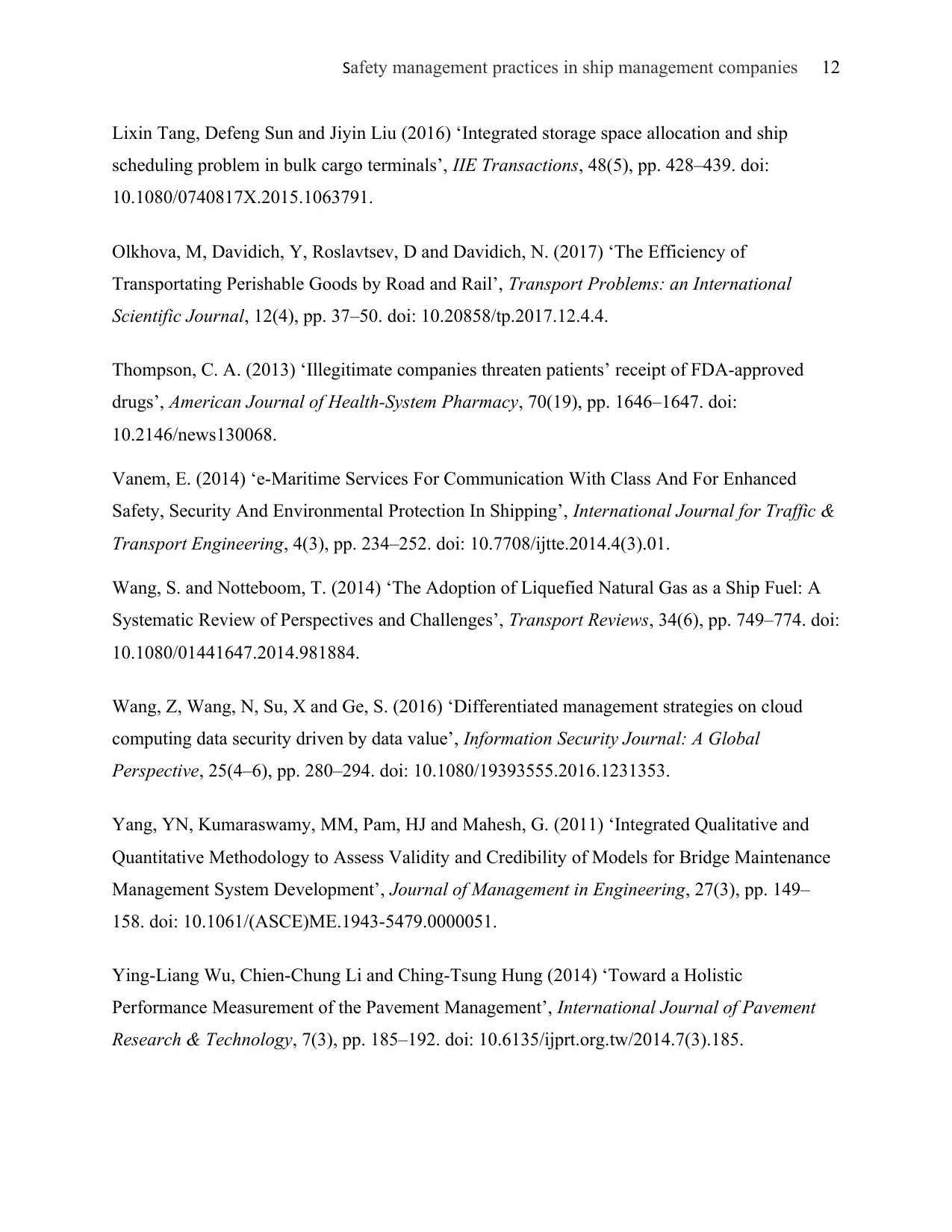
Safety management practices in ship management companies 12
Lixin Tang, Defeng Sun and Jiyin Liu (2016) ‘Integrated storage space allocation and ship
scheduling problem in bulk cargo terminals’, IIE Transactions, 48(5), pp. 428–439. doi:
10.1080/0740817X.2015.1063791.
Olkhova, M, Davidich, Y, Roslavtsev, D and Davidich, N. (2017) ‘The Efficiency of
Transportating Perishable Goods by Road and Rail’, Transport Problems: an International
Scientific Journal, 12(4), pp. 37–50. doi: 10.20858/tp.2017.12.4.4.
Thompson, C. A. (2013) ‘Illegitimate companies threaten patients’ receipt of FDA-approved
drugs’, American Journal of Health-System Pharmacy, 70(19), pp. 1646–1647. doi:
10.2146/news130068.
Vanem, E. (2014) ‘e-Maritime Services For Communication With Class And For Enhanced
Safety, Security And Environmental Protection In Shipping’, International Journal for Traffic &
Transport Engineering, 4(3), pp. 234–252. doi: 10.7708/ijtte.2014.4(3).01.
Wang, S. and Notteboom, T. (2014) ‘The Adoption of Liquefied Natural Gas as a Ship Fuel: A
Systematic Review of Perspectives and Challenges’, Transport Reviews, 34(6), pp. 749–774. doi:
10.1080/01441647.2014.981884.
Wang, Z, Wang, N, Su, X and Ge, S. (2016) ‘Differentiated management strategies on cloud
computing data security driven by data value’, Information Security Journal: A Global
Perspective, 25(4–6), pp. 280–294. doi: 10.1080/19393555.2016.1231353.
Yang, YN, Kumaraswamy, MM, Pam, HJ and Mahesh, G. (2011) ‘Integrated Qualitative and
Quantitative Methodology to Assess Validity and Credibility of Models for Bridge Maintenance
Management System Development’, Journal of Management in Engineering, 27(3), pp. 149–
158. doi: 10.1061/(ASCE)ME.1943-5479.0000051.
Ying-Liang Wu, Chien-Chung Li and Ching-Tsung Hung (2014) ‘Toward a Holistic
Performance Measurement of the Pavement Management’, International Journal of Pavement
Research & Technology, 7(3), pp. 185–192. doi: 10.6135/ijprt.org.tw/2014.7(3).185.
Lixin Tang, Defeng Sun and Jiyin Liu (2016) ‘Integrated storage space allocation and ship
scheduling problem in bulk cargo terminals’, IIE Transactions, 48(5), pp. 428–439. doi:
10.1080/0740817X.2015.1063791.
Olkhova, M, Davidich, Y, Roslavtsev, D and Davidich, N. (2017) ‘The Efficiency of
Transportating Perishable Goods by Road and Rail’, Transport Problems: an International
Scientific Journal, 12(4), pp. 37–50. doi: 10.20858/tp.2017.12.4.4.
Thompson, C. A. (2013) ‘Illegitimate companies threaten patients’ receipt of FDA-approved
drugs’, American Journal of Health-System Pharmacy, 70(19), pp. 1646–1647. doi:
10.2146/news130068.
Vanem, E. (2014) ‘e-Maritime Services For Communication With Class And For Enhanced
Safety, Security And Environmental Protection In Shipping’, International Journal for Traffic &
Transport Engineering, 4(3), pp. 234–252. doi: 10.7708/ijtte.2014.4(3).01.
Wang, S. and Notteboom, T. (2014) ‘The Adoption of Liquefied Natural Gas as a Ship Fuel: A
Systematic Review of Perspectives and Challenges’, Transport Reviews, 34(6), pp. 749–774. doi:
10.1080/01441647.2014.981884.
Wang, Z, Wang, N, Su, X and Ge, S. (2016) ‘Differentiated management strategies on cloud
computing data security driven by data value’, Information Security Journal: A Global
Perspective, 25(4–6), pp. 280–294. doi: 10.1080/19393555.2016.1231353.
Yang, YN, Kumaraswamy, MM, Pam, HJ and Mahesh, G. (2011) ‘Integrated Qualitative and
Quantitative Methodology to Assess Validity and Credibility of Models for Bridge Maintenance
Management System Development’, Journal of Management in Engineering, 27(3), pp. 149–
158. doi: 10.1061/(ASCE)ME.1943-5479.0000051.
Ying-Liang Wu, Chien-Chung Li and Ching-Tsung Hung (2014) ‘Toward a Holistic
Performance Measurement of the Pavement Management’, International Journal of Pavement
Research & Technology, 7(3), pp. 185–192. doi: 10.6135/ijprt.org.tw/2014.7(3).185.
⊘ This is a preview!⊘
Do you want full access?
Subscribe today to unlock all pages.

Trusted by 1+ million students worldwide
1 out of 13
Your All-in-One AI-Powered Toolkit for Academic Success.
+13062052269
info@desklib.com
Available 24*7 on WhatsApp / Email
![[object Object]](/_next/static/media/star-bottom.7253800d.svg)
Unlock your academic potential
Copyright © 2020–2025 A2Z Services. All Rights Reserved. Developed and managed by ZUCOL.


